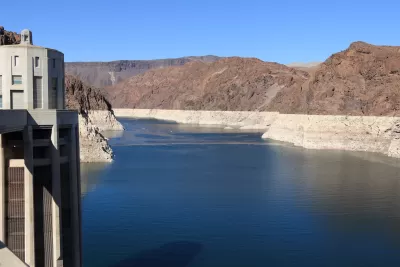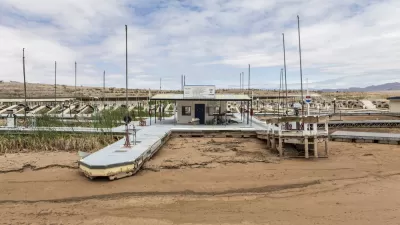New agreements and the first cutbacks in water usage signal the start of concerted efforts keep the river and reservoirs from dropping to dangerous levels.

Ian James reports that water deliveries from the Colorado River will be reduced for Arizona, Nevada, and Mexico next year. Projections show that the water level of Lake Mead, which is now 39 percent full, will drop to below threshold levels at the start of the year. California and Mexico have also agreed to contribute water to the reservoir if levels continue to drop.
"The Colorado River’s reservoirs have dropped dramatically since 2000 during one of the most extreme droughts in centuries. Farms and cities across the Southwest have long been taking more from the river than what flows into it, and climate change is adding to the strains by pushing up temperatures," notes James.
This is the first time such restrictions have gone into place. Even with a winter of heavy snows that increased runoff into Lake Mead, reduced stream flow and more evaporation in past years from rising temperatures were pointing to future shortages.
"[Jennifer Pitt] said having the drought agreement in place now gives water managers several years to study scenarios of extremes, and come up with new rules to 'create the resilience that we need in the Colorado River basin to respond to whatever conditions are coming our way,'" notes James.
FULL STORY: First-ever mandatory water cutbacks will kick in next year along the Colorado River

Alabama: Trump Terminates Settlements for Black Communities Harmed By Raw Sewage
Trump deemed the landmark civil rights agreement “illegal DEI and environmental justice policy.”

Planetizen Federal Action Tracker
A weekly monitor of how Trump’s orders and actions are impacting planners and planning in America.

Why Should We Subsidize Public Transportation?
Many public transit agencies face financial stress due to rising costs, declining fare revenue, and declining subsidies. Transit advocates must provide a strong business case for increasing public transit funding.

Understanding Road Diets
An explainer from Momentum highlights the advantages of reducing vehicle lanes in favor of more bike, transit, and pedestrian infrastructure.

New California Law Regulates Warehouse Pollution
A new law tightens building and emissions regulations for large distribution warehouses to mitigate air pollution and traffic in surrounding communities.

Phoenix Announces Opening Date for Light Rail Extension
The South Central extension will connect South Phoenix to downtown and other major hubs starting on June 7.
Urban Design for Planners 1: Software Tools
This six-course series explores essential urban design concepts using open source software and equips planners with the tools they need to participate fully in the urban design process.
Planning for Universal Design
Learn the tools for implementing Universal Design in planning regulations.
Caltrans
Smith Gee Studio
Institute for Housing and Urban Development Studies (IHS)
City of Grandview
Harvard GSD Executive Education
Toledo-Lucas County Plan Commissions
Salt Lake City
NYU Wagner Graduate School of Public Service




























